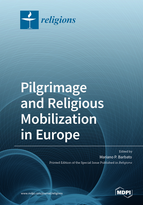Pilgrimage and Religious Mobilization in Europe
A special issue of Religions (ISSN 2077-1444).
Deadline for manuscript submissions: closed (1 December 2021) | Viewed by 30494
Special Issue Editor
2. Faculty of Philosophy, University of Passau, 94030 Passau, Germany
Interests: political science; international relations; political theory; history; religion and politics; Europe; pilgrim studies; papacy
Special Issues, Collections and Topics in MDPI journals
Special Issue Information
Dear Colleagues,
“Europe is born on a pilgrimage.” This phrase, often ascribed to the German poet Johann Wolfgang von Goethe, might be apocryphal but it captures the important role of this ongoing practice in Europe. In a secularizing continent, pilgrimage is a religious ritual that is not only still flourishing but on the rise.
Religions typically have a public dimension of social gathering, arguing, and worship. The ritual of pilgrimage constitutes in many religions an important expression of this public dimension. Christianity, in particular Catholicism, is still the first religion that comes to mind when thinking about pilgrimage in Europe, but it is by far not the only community that engages in this praxis.
Pilgrimage has dimensions beyond the religious experience. Pilgrimages can spill over into various ways of religious mobilization with a social, political, and also economic impact. When religious experiences meet with cultural landscapes and economic interests, questions of political power begin to rise. Varieties of pilgrimage from spiritual tourism to religious protest shape the public dimension of pilgrimage and have an impact on various levels of European societies.
Pilgrim Studies is an emerging interdisciplinary field that takes these various sociological, cultural, geographical, economic, and political implications into account.
The present Special Issue seeks to continue and elaborate on the existing research agendas and to establish a forum for new approaches, historical traditions, current trends, comparative approaches, conceptual developments, and methodological questions are of interest. Whose frames guide the pilgrims? Who profits from the pilgrims’ decisions? What kind of identity emerges when pilgrims depart and return?
The volume invites contributions from the fields of political science, history, geography, theology, sociology, religious studies, philosophy, anthropology, media studies, literature studies, tourism and travel studies, and the whole range of humanities and social science. The Special Issue encourages the submission of a broad range of papers from disciplinary, interdisciplinary, and multidisciplinary perspectives in order to elaborate on the empirical and theoretical aspects of all forms of pilgrimage and related religious mobilization in Europe. The following themes may be included: historical and current pilgrimages of Europeans and in Europe; paths, events, spaces, landscapes, and persons of pilgrims’ interest; social, political, and economic impacts of pilgrimages, religious mobilization spilling over from pilgrimages or constituting pilgrimages; religious rituals; music, art, icons, cultural heritage; pilgrim popes and papal pilgrims, power and pilgrimage, economy of pilgrimage, spiritual tourism; political mobilization of pilgrims, Santiago de Compostela and the Way of St. James; Marian devotions, Holy Land, Jerusalem, Rome, Via Francigena, Canterbury, Mount Athos, Assisi, Saint Michael, Sacred Heart, Holy Shroud, Image of the Divine Mercy, Egeria, Labre; wandering monks and virgins, folk piety, crusades, material religion, rite de passage, Turner, critique of pilgrimage and wayfarer, Pilgrim’s Progress, Pilgrim City, Pilgrim’s Tale, homo viator, local shrines, saints, Uman, Oberammergau, Taizé, World Youth Day, Holy Year, virtual pilgrims.
Prof. Dr. Mariano P. Barbato
Guest Editor
Manuscript Submission Information
Manuscripts should be submitted online at www.mdpi.com by registering and logging in to this website. Once you are registered, click here to go to the submission form. Manuscripts can be submitted until the deadline. All submissions that pass pre-check are peer-reviewed. Accepted papers will be published continuously in the journal (as soon as accepted) and will be listed together on the special issue website. Research articles, review articles as well as short communications are invited. For planned papers, a title and short abstract (about 100 words) can be sent to the Editorial Office for announcement on this website.
Submitted manuscripts should not have been published previously, nor be under consideration for publication elsewhere (except conference proceedings papers). All manuscripts are thoroughly refereed through a double-blind peer-review process. A guide for authors and other relevant information for submission of manuscripts is available on the Instructions for Authors page. Religions is an international peer-reviewed open access monthly journal published by MDPI.
Please visit the Instructions for Authors page before submitting a manuscript. The Article Processing Charge (APC) for publication in this open access journal is 1800 CHF (Swiss Francs). Submitted papers should be well formatted and use good English. Authors may use MDPI's English editing service prior to publication or during author revisions.
Keywords
- pilgrimage
- pilgrims
- mobilization
- Europe






